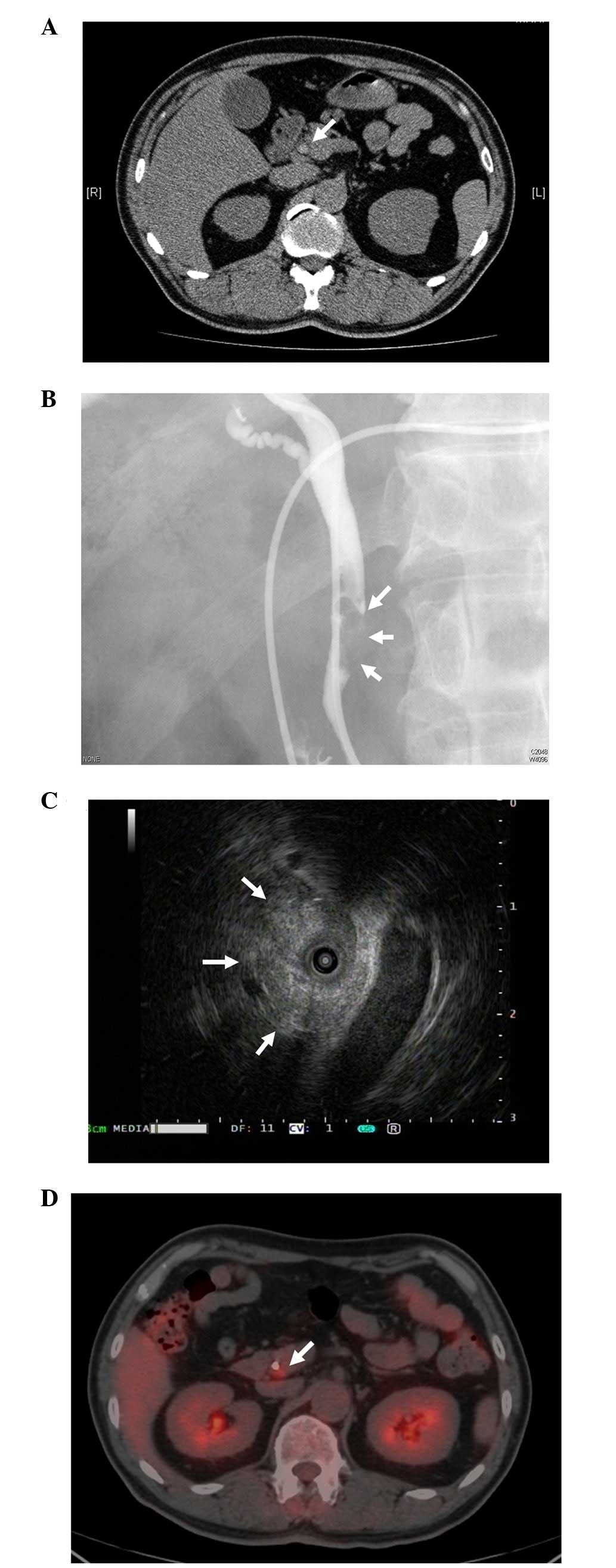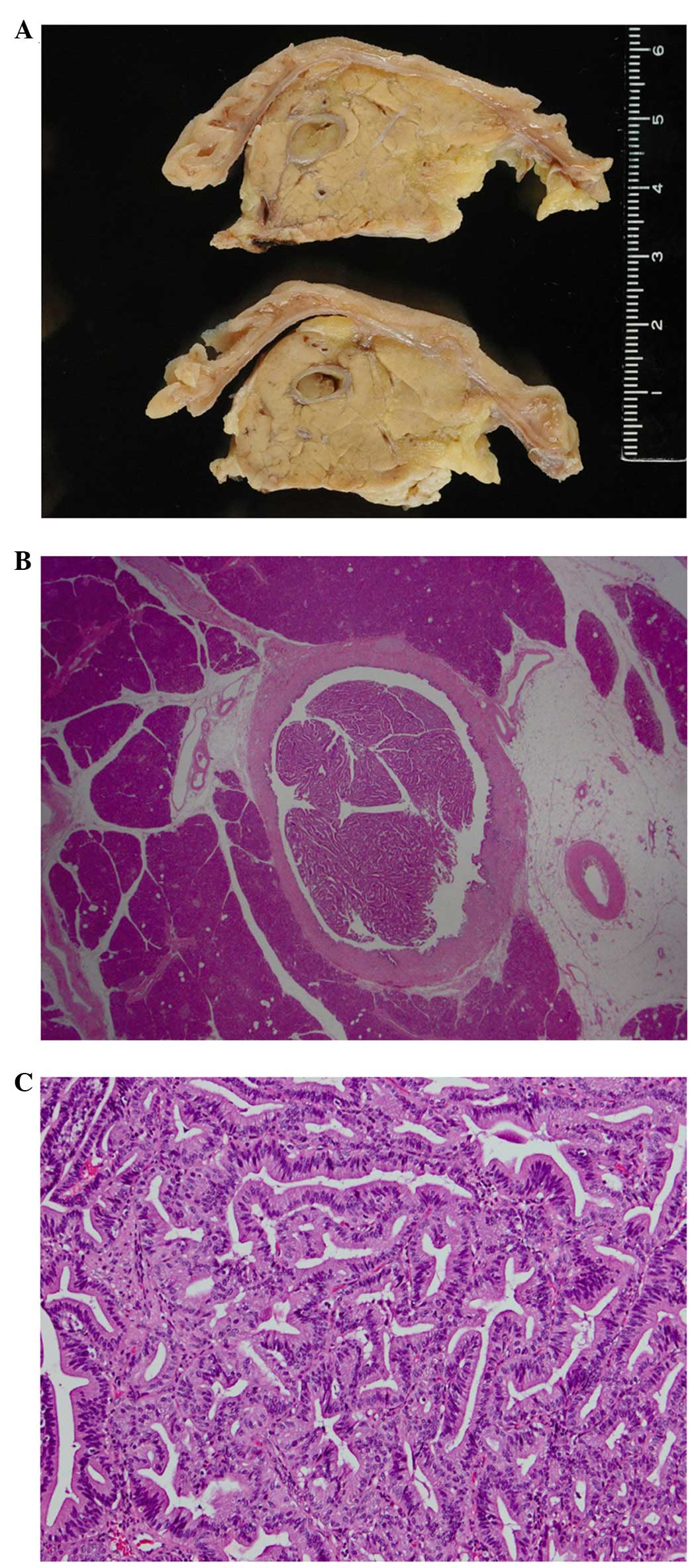|
1
|
Kim BS, Joo SH and Joo KR: Carcinoma in
situ arising in a tubulovillous adenoma of the distal common
bile duct: A case report. World J Gastroenterol. 14:4705–4708.
2008. View Article : Google Scholar : PubMed/NCBI
|
|
2
|
Fletcher ND, Wise PE and Sharp KW: Common
bile duct papillary adenoma causing obstructive jaundice: Case
report and review of the literature. Am Surg. 70:448–452.
2004.PubMed/NCBI
|
|
3
|
Abraham SC, Lee JH, Hruban RH, Argani P,
Furth EE and Wu TT: Molecular and immunohistochemical analysis of
intraductal papillary neoplasms of the biliary tract. Hum Pathol.
34:902–910. 2003. View Article : Google Scholar : PubMed/NCBI
|
|
4
|
Zen Y, Fujii T, Itatsu K, Nakamura K,
Minato H, Kasashima S, Kurumaya H, Katayanagi K, Kawashima A,
Masuda S, et al: Biliary papillary tumors share pathological
features with intraductal papillary mucinous neoplasm of the
pancreas. Hepatology. 44:1333–1343. 2006. View Article : Google Scholar : PubMed/NCBI
|
|
5
|
Kim KM, Lee JK, Shin JU, Lee KH, Lee KT,
Sung JY, Jang KT, Heo JS, Choi SH, Choi DW and Lim JH:
Clinicopathologic features of intraductal papillary neoplasm of the
bile duct according to histologic subtype. Am J Gastroenterol.
107:118–125. 2012. View Article : Google Scholar : PubMed/NCBI
|
|
6
|
Kluge R, Schmidt F, Caca K, Barthel H,
Hesse S, Georgi P, Seese A, Huster D and Berr F: Positron emission
tomography with [(18)F]fluoro-2-deoxy-D-glucose for diagnosis and
staging of bile duct cancer. Hepatology. 33:1029–1035. 2001.
View Article : Google Scholar : PubMed/NCBI
|
|
7
|
Hasebe T, Sakamoto M, Mukai K, Kawano N,
Konishi M, Ryu M, Fukamachi S and Hirohashi S: Cholangiocarcinoma
arising in bile duct adenoma with focal area of bile duct
hamartoma. Virchows Arch. 426:209–213. 1995. View Article : Google Scholar : PubMed/NCBI
|
|
8
|
Serafini FM and Carey LC: Adenoma of the
ampulla of Vater: A genetic condition? HPB Surg. 11:191–193. 1999.
View Article : Google Scholar : PubMed/NCBI
|
|
9
|
Sato T, Konishi K, Kimura H, Maeda K,
Yabushita K, Tsuji M and Miwa A: Adenoma and tiny carcinoma in
adenoma of the papilla of Vater - p53 and PCNA.
Hepatogastroenterology. 46:1959–1962. 1999.PubMed/NCBI
|
|
10
|
Genc H, Haciyanli M, Tavusbay C, Colakoglu
O, Aksöz K, Unsal B and Ekinci N: Carcinoma arising from villous
adenoma of the ampullary bile duct: Report of a case. Surg Today.
37:165–168. 2007. View Article : Google Scholar : PubMed/NCBI
|
|
11
|
Takashima M, Ueki T, Nagai E, Yao T,
Yamaguchi K, Tanaka M and Tsuneyoshi M: Carcinoma of the ampulla of
Vater associated with or without adenoma: A clinicopathologic
analysis of 198 cases with reference to p53 and Ki-67
immunohistochemical expressions. Mod Pathol. 13:1300–1307. 2000.
View Article : Google Scholar : PubMed/NCBI
|
|
12
|
Kaiser A, Jurowich C, Schönekäs H,
Gebhardt C and Wünsch PH: The adenoma-carcinoma sequence applies to
epithelial tumours of the papilla of Vater. Z Gastroenterol.
40:913–920. 2002. View Article : Google Scholar : PubMed/NCBI
|
|
13
|
Schlitter AM, Born D, Bettstetter M,
Specht K, Kim-Fuchs C, Riener MO, Jeliazkova P, Sipos B, Siveke JT,
Terris B, et al: Intraductal papillary neoplasms of the bile duct:
Stepwise progression to carcinoma involves common molecular
pathways. Mod Pathol. 27:73–86. 2014. View Article : Google Scholar : PubMed/NCBI
|
|
14
|
Sturgis TM, Fromkes JJ and Marsh W Jr:
Adenoma of the common bile duct: Endoscopic diagnosis and
resection. Gastrointest Endosc. 38:504–506. 1992. View Article : Google Scholar : PubMed/NCBI
|
|
15
|
Munshi AG and Hassan MA: Common bile duct
adenoma: Case report and brief review of literature. Surg Laparosc
Endosc Percutan Tech. 20:e193–e194. 2010. View Article : Google Scholar : PubMed/NCBI
|
|
16
|
Kubota K: From tumor biology to clinical
Pet: A review of positron emission tomography (PET) in oncology.
Ann Nucl Med. 15:471–486. 2001. View Article : Google Scholar : PubMed/NCBI
|
|
17
|
Bomanji JB, Costa DC and Ell PJ: Clinical
role of positron emission tomography in oncology. Lancet Oncol.
2:157–164. 2001. View Article : Google Scholar : PubMed/NCBI
|
|
18
|
Kitamura K, Hatano E, Higashi T, Seo S,
Nakamoto Y, Narita M, Taura K, Yasuchika K, Nitta T, Yamanaka K, et
al: Prognostic value of (18)F-fluorodeoxyglucose positron emission
tomography in patients with extrahepatic bile duct cancer. J
Hepatobiliary Pancreat Sci. 18:39–46. 2011. View Article : Google Scholar : PubMed/NCBI
|
|
19
|
Yamada H, Hosokawa M, Itoh K, Takenouchi
T, Kinoshita Y, Kikkawa T, Sakashita K, Uemura S, Nishida Y, Kusumi
T and Sasaki S: Diagnostic value of 18F-FDG PET/CT for
lymph node metastasis of esophageal squamous cell carcinoma. Surg
Today. 44:1258–1265. 2014. View Article : Google Scholar : PubMed/NCBI
|
|
20
|
Nishiyama Y, Yamamoto Y, Kimura N, Miki A,
Sasakawa Y, Wakabayashi H and Ohkawa M: Comparison of early and
delayed FDG PET for evaluation of biliary stricture. Nucl Med
Commun. 28:914–919. 2007. View Article : Google Scholar : PubMed/NCBI
|
|
21
|
Choi EK, Yoo IeR, Kim SH, O JH, Choi WH,
Na SJ and Park SY: The clinical value of dual-time point 18F-FDG
PET/CT for differentiating extrahepatic cholangiocarcinoma from
benign disease. Clin Nucl Med. 38:e106–e111. 2013. View Article : Google Scholar : PubMed/NCBI
|
|
22
|
Annunziata S, Caldarella C, Pizzuto DA,
Galiandro F, Sadeghi R, Giovanella L and Treglia G: Diagnostic
accuracy of fluorine-18-fluorodeoxyglucose positron emission
tomography in the evaluation of the primary tumor in patients with
cholangiocarcinoma: A meta-analysis. BioMed Res Int.
2014:2476932014. View Article : Google Scholar : PubMed/NCBI
|
|
23
|
Albazaz R, Patel CN, Chowdhury FU and
Scarsbrook AF: Clinical impact of FDG PET-CT on management
decisions for patients with primary biliary tumours. Insights
Imaging. 4:691–700. 2013. View Article : Google Scholar : PubMed/NCBI
|
|
24
|
van Kouwen MC, Nagengast FM, Jansen JB,
Oyen WJ and Drenth JP: 2-(18F)-fluoro-2-deoxy-D-glucose positron
emission tomography detects clinical relevant adenomas of the
colon: A prospective study. J Clin Oncol. 23:3713–3717. 2005.
View Article : Google Scholar : PubMed/NCBI
|
|
25
|
Yasuda S, Fujii H, Nakahara T, Nishiumi N,
Takahashi W, Ide M and Shohtsu A: 18F-FDG PET detection of colonic
adenomas. J Nucl Med. 42:989–992. 2001.PubMed/NCBI
|
|
26
|
Dong A, Dong H, Zhang L and Zuo C: F-18
FDG uptake in borderline intraductal papillary neoplasms of the
bile duct. Ann Nucl Med. 26:594–598. 2012. View Article : Google Scholar : PubMed/NCBI
|
|
27
|
Wakabayashi H, Akamoto S, Yachida S, Okano
K, Izuishi K, Nishiyama Y and Maeta H: Significance of
fluorodeoxyglucose PET imaging in the diagnosis of malignancies in
patients with biliary stricture. Eur J Surg Oncol. 31:1175–1179.
2005. View Article : Google Scholar : PubMed/NCBI
|
|
28
|
Anderson CD, Rice MH, Pinson CW, Chapman
WC, Chari RS and Delbeke D: Fluorodeoxyglucose PET imaging in the
evaluation of gallbladder carcinoma and cholangiocarcinoma. J
Gastrointest Surg. 8:90–97. 2004. View Article : Google Scholar : PubMed/NCBI
|
















